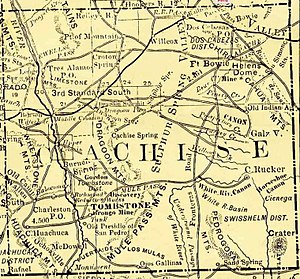 Cochise County in 1881, at the beginning of the region's silver boom | |
| Date | c. 1850 – 1910 |
|---|---|
| Location | Cochise County, Arizona Territory |
Cochise County in southeastern Arizona was the scene of a number of violent conflicts in the 19th-century and early 20th-century American Old West, including between white settlers and Apache Indians, between opposing political and economic factions, and between outlaw gangs and local law enforcement. Cochise County was carved off in 1881 from the easternmost portion of Pima County during a formative period in the American Southwest. The era was characterized by rapidly growing boomtowns, the emergence of large-scale farming and ranching interests, lucrative mining operations, and the development of new technologies in railroading and telecommunications. Complicating the situation was staunch resistance to white settlement from local Native American groups, most notably during the Apache Wars, as well as Cochise County's location on the border with Mexico, which not only threatened international conflict but also presented opportunities for criminal smugglers and cattle rustlers.
Factional hostilities emerged as soon as American settlers began arriving in southern Arizona in large numbers in the 1860s and 1870s. The Gadsden Purchase of 1853 had opened the territory to Americans, and the sudden growth of settlement and investment proved a source of great enmity between local Apaches and the American newcomers. Pima County and later Cochise County were the primary battleground for most of the resulting quarter-century of warfare, which was almost constant in the region until the late 1880s.
In addition to the Native American conflicts, there was also considerable tension between rural residents of Cochise County, who were for the most part Democrats from the agrarian Confederate States, and more urban residents living within the region's few developed towns, who were largely Republican business owners from the industrial Union States. The division created polarizing sectional alliances and culminated in countless local feuds, the most well-known of which has been called the Cochise County feud or the Earp–Clanton feud, which included the historic Gunfight at the O.K. Corral in the town of Tombstone and Wyatt Earp's Vendetta Ride in the early 1880s. Dr. George E. Goodfellow famously described Tombstone, the capital of Cochise County, as the "condensation of wickedness."[1]
- ^ Edwards, Josh (May 2, 1980). "George Goodfellow's Medical Treatment of Stomach Wounds Became Legendary". The Prescott Courier. pp. 3–5.